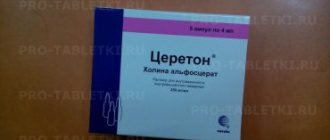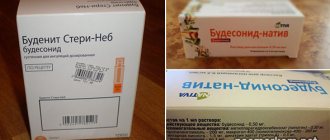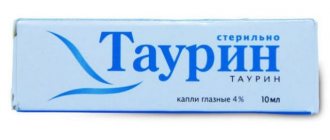Aerosol Atrovent N is a bronchodilator for blocking m-cholinergic receptors and suppressing reflex. Peak effectiveness is observed 1 to 2 hours after taking the drug. The result lasts up to 4-6 hours. The product has a local effect on the lungs, protecting the body from systemic effects.
Registration number: P N014363/01
Trade (proprietary) name: Atrovent N
International nonproprietary name: Ipratropium bromide
Dosage form: dosed aerosol for inhalation
Photo of aerosol Atrovent N with the composition indicated
Aerosol Atrovent N composition
1 inhalation dose contains:
Active ingredient: ipratropium bromide monohydrate 0.021 mg (21 mcg), which corresponds to ipratropium bromide anhydrous 0.020 mg (20 mcg). Excipients: absolute ethanol 8.415 mg, purified water 0.281 mg, citric acid 0.002 mg, tetrafluoroethane (HFA134a, propellant) 47.381 mg.
Description
A clear, colorless liquid, free of suspended particles, placed under pressure in a one-piece stainless steel container equipped with a dosing valve with a plastic rod.
Pharmacological group: m-anticholinergic agent
ATX code: R03BB01
Pharmacological properties
Bronchodilator. Blocks m-cholinergic receptors of the smooth muscles of the tracheobronchial tree and suppresses reflex bronchoconstriction. Having structural similarity to the acetylcholine molecule, it is its competitive antagonist. Anticholinergics prevent an increase in the intracellular concentration of calcium ions, which occurs due to the interaction of acetylcholine with muscarinic receptors located in the smooth muscles of the bronchi.
The release of calcium ions occurs with the help of secondary messengers (mediators), which include ITP (inositol triphosphate) and DAG (diacylglycerol). Effectively prevents the narrowing of the bronchi that occurs as a result of inhalation of cigarette smoke, cold air, the action of various bronchospasms, and also eliminates bronchospasm associated with the influence of the vagus nerve. When used inhalation, it has virtually no resorptive effect. Bronchodilation occurring after inhalation of ATROVENT N (ipratropium bromide) is mainly a consequence of the local and specific effect of the drug on the lungs, and not the result of its systemic effect.
In controlled 85-90 day studies conducted in patients with bronchospasm due to chronic obstructive pulmonary disease, chronic bronchitis and emphysema, significant improvement in lung function was observed within 15 minutes, peaked at 1-2 hours and was maintained for 4-6 hours. hours. In patients with bronchial asthma, a significant improvement in external respiratory function is observed in 51% of patients.
Pharmacokinetics
The therapeutic effect of ATROVENT N is a consequence of its local action in the respiratory tract. The development of bronchodilation does not parallel pharmacokinetic parameters. After inhalation, 10-30% of the administered dose of the drug usually reaches the lungs (depending on the dosage form and method of inhalation). Most of the dose is swallowed and enters the gastrointestinal tract. Part of the drug dose that enters the lungs quickly reaches the systemic bloodstream (within a few minutes).
Cumulative renal excretion (over 24 hours) of the parent compound is approximately 46% of the intravenous dose, less than 1% of the oral dose, and approximately 3-13% of the inhalation dose. Based on these data, the total systemic bioavailability of ipratropium bromide administered orally and inhaled is calculated to be 2% and 7-28%, respectively.
Kinetic parameters describing the distribution of ipratropium bromide were calculated based on its plasma concentrations after intravenous administration. A rapid two-phase decrease in plasma concentration is observed. The apparent volume of distribution during steady state (Css) is approximately 176 L (= 2.4 L/kg). The drug binds to plasma proteins to a minimal extent (less than 20%).
Ipratropium bromide, which is a quaternary amine, does not penetrate the blood-brain barrier. The half-life during the terminal phase is approximately 1.6 hours. The total clearance of ipratropium bromide is 2.3 l/min, and the renal clearance is 0.9 l/min. After intravenous administration, approximately 60% of the dose is metabolized by oxidation, mainly in the liver.
Cumulative renal excretion (over 6 days) of the isotopically labeled dose (including parent compound and all metabolites) was 72.1% after intravenous administration, 9.3% after oral administration, and 3.2% after inhalation administration. The total isotope-labeled dose excreted through the intestines was 6.3% after intravenous administration, 88.5% after oral administration, and 69.4% after inhalation administration. Thus, excretion of the isotope-labeled dose after intravenous administration is carried out in mainly through the kidneys. The half-life of the parent compound and metabolites is 3.6 hours. The main metabolites excreted in the urine bind weakly to muscarinic receptors and are considered inactive.
Similar drugs
What analogues exist for Atrovent? In some cases, the use of Atrovent can be replaced with the drug Ipravent, which also contains ipratropium bromide. The drug helps relax the smooth muscles of the bronchi, preventing spasms. The medicine can be used in the form of an aerosol can; the side effects from using both drugs are identical.
Note! Analogues of Atrovent can only be selected by a pulmonologist based on the medical history.
Berodual is another drug with a similar effect, which contains ipratropium bromide. The difference between Berodual is the presence of fenoterol hydrobromide in the treatment formula, that is, the drug has a broader effect on the body.
It is intended for the rapid relief of asthma attacks, in which it undoubtedly surpasses Atrovent in speed and effectiveness. However, Berodual also has a wider list of contraindications and restrictions on use, so Atrovent is used at the initial stage of treatment.
Atrovent n contraindications
Hypersensitivity to atropine and its derivatives; hypersensitivity to ipratropium bromide or other components of the drug; pregnancy (first trimester); the drug is contraindicated in patients who have previously had an allergy to soy or peanuts. In such patients, other dosage forms of ATROVENT N (inhalation solutions) that do not contain soy lecithin can be used.
Pregnancy and lactation
The safety of ATROVENT N during pregnancy in humans has not been established. When prescribing the drug during a possible or confirmed pregnancy, the ratio of the expected benefit of the drug and the possible risk to the fetus should be taken into account. In preclinical studies, embryotoxic and teratogenic effects of the drug were not detected when administered in inhalation and intranasal doses significantly exceeding the recommended therapeutic dose for humans. There are no data on the penetration of ATROVENT N into breast milk. Although insoluble quaternary cations pass into breast milk, ATROVENT N is unlikely to have significant effects when administered inhaled. However, since many drugs are excreted in breast milk, ATROVENT N should be prescribed with caution to women during lactation.
Indications for use
The drug is prescribed in the following cases:
- suffocation;
- obstructive bronchitis;
- emphysema;
- bronchial asthma;
- chronic lung diseases;
- bronchospasms after colds;
- expansion of bronchial lumens before using aerosols.
The following conditions are contraindications to the use of the medicine:
- early stages of pregnancy;
- suspected pregnancy;
- children up to six years of age.
The spray should not be used in children under six years of age with pathological conditions of the bronchopulmonary system. The inhalation solution should not be used for the same conditions in children under five years of age.
The drug may be prescribed to nursing mothers, patients with closed-angle glaucoma and pathological processes in the prostate gland - but with great caution.
Aerosol Atrovent N dosage and method of administration
Dosing should be done individually. During treatment, patients must be under medical supervision. The recommended daily dose should not be exceeded during either acute or maintenance therapy. If treatment does not lead to significant improvement or the patient’s condition worsens, a doctor’s consultation is necessary to develop a new treatment plan. If shortness of breath (difficulty breathing) suddenly or rapidly worsens, consult your doctor immediately. The following dosages are recommended (unless another dosage regimen is prescribed):
Adults and children over 6 years of age:
2 inhalation doses (injection) 4 times a day. Since the need for increasing doses indicates the possible need for additional treatment methods, as a rule, more than 12 inhalation doses should not be used per day. For the treatment of sudden exacerbations of chronic obstructive pulmonary disease, ATROVENT inhalation solution may be indicated. In children, metered-dose aerosol ATROVENT N should be used only after consulting a doctor and under adult supervision (due to insufficient information).
Using a metered aerosol
Correct application is essential for successful therapy.
Before first use.
Before using the inhaler for the first time, press the bottom of the canister 2 times.
Before each use, the following rules must be observed:
- Remove the protective cap.
- Take a deep breath.
- Hold the inhaler as shown in Fig. 2 and wrap your lips tightly around the mouthpiece. The arrow and the bottom of the cylinder should be directed upward.
- Take as deep a breath as possible and at the same time sharply press the bottom of the balloon. This will release one inhalation dose. Hold your breath for a few seconds, then remove the mouthpiece from your mouth and exhale. Repeat the same steps to receive the second inhalation dose.
- After using the inhaler, put on the protective cap.
- If the metered dose aerosol inhaler is not used for three days, press the valve once before using it. The container is not transparent, so it is impossible to determine by eye when it becomes empty.
The inhaler contains 200 inhalation doses. After all doses have been used, the container may still seem to contain a small amount of liquid. However, in such cases the inhaler must be replaced, as it may contain an insufficient amount of the drug.
The amount of drug in your inhaler can be checked in the following way:
Shake the container, this will show whether there is any liquid left in it.
Another way.
Remove the plastic mouthpiece from the balloon and place the balloon in a container of water. The contents of the cylinder can be estimated depending on its position in the water. Clean your inhaler at least once a week. It is important to keep the mouthpiece of the inhaler clean to prevent any drug from getting into it, which could block the release of the aerosol. When cleaning, first remove the protective cap and remove the canister from the inhaler. Run a stream of warm water through the inhaler, making sure to remove the drug and/or visible dirt. After cleaning, shake the inhaler and allow it to air dry without using heat. Once the mouthpiece is dry, insert the canister into the inhaler and put on the protective cap.
Cautions:
The plastic mouthpiece was designed specifically for the use of metered-dose aerosol ATROVENT N and serves for precise dosing of this drug. This mouthpiece should not be used with other metered dose aerosols. You should also not use ATROVENT N metered dose aerosol with other mouthpieces. The aerosol in the container is under pressure. The cylinder must not be opened or stored at temperatures above 50°C.
special instructions
Before using Atrovent, it is necessary to teach the patient how to use the inhaler correctly.
The drug is not recommended to be prescribed to relieve an attack of bronchial asthma due to the delayed development of the bronchodilator effect.
It is possible to combine inhalations of Atrovent with Ambroxol, Bromhexine or Berotec.
The drug should not come into contact with the eyes due to the risk of developing glaucoma in case of predisposition to the disease.
For inhalation, it is advisable to use nebulizers that have a mouth tip.
Atrovent N side effects
Many of the listed undesirable effects may be a consequence of the anticholinergic properties of ATROVENT N. ATROVENT N, like any inhalation therapy, may cause local irritation. Adverse reactions to the drug were determined based on data obtained in clinical trials and during pharmacological surveillance of the use of the drug after its registration. The most common side effects reported in clinical studies were headache, pharyngeal irritation, cough, dry mouth, gastrointestinal motility disorders (including constipation, diarrhea and vomiting), nausea and dizziness.
Immune system disorders:
- hypersensitivity
- anaphylactic reaction
Nervous system disorders:
- headache
- dizziness
Visual disorders:
- blurred vision
- mydriasis
- increased intraocular pressure
- glaucoma
- Pain in the eyes
- the appearance of a halo around objects
- conjunctival hyperemia
- corneal edema
- disturbances of accommodation
Cardiac disorders:
- feeling of heartbeat
- supraventricular tachycardia
- atrial fibrillation
- increased heart rate
Respiratory, thoracic and mediastinal disorders:
- throat irritation cough
- bronchospasm
- paradoxical bronchospasm
- laryngospasm
- swelling of the pharynx
- dry throat
Gastrointestinal disorders:
- dry mouth
- nausea
- gastrointestinal motility disorders
- diarrhea
- constipation
- vomit
- stomatitis
- swelling of the mouth
Changes in the skin and subcutaneous tissues:
- rash
- itching
- angioedema
- hives
Renal and urinary tract disorders:
- urinary retention
Overdose
No specific overdose symptoms were identified. Given the breadth of therapeutic action and the local route of administration of ATROVENT N, the occurrence of any serious anticholinergic symptoms is unlikely. Minor manifestations of systemic anticholinergic action are possible, such as dry mouth, visual disturbances, and increased heart rate. Treatment is symptomatic.
Interactions with other drugs
Beta2-adrenergic agents and xanthine derivatives may enhance the bronchodilator effect of the drug. The anticholinergic effect is enhanced by antiparkinsonian drugs, quinidine, and tricyclic antidepressants. When used simultaneously with other anticholinergic drugs, there is an additive effect.
special instructions
Patients with cystic fibrosis are at increased risk of developing slow gastrointestinal motility. Immediate hypersensitivity reactions may occur following use of ATROVENT N, as indicated by rare cases of rash, urticaria, angioedema, oropharyngeal edema, bronchospasm and anaphylaxis. ATROVENT N should be used with caution in patients predisposed to acute-angle glaucoma or in patients with concomitant urinary tract obstruction (eg, prostatic hyperplasia or bladder neck obstruction). Care should be taken to prevent aerosol from getting into the eyes. Since the metered aerosol is applied through a mouthpiece and the use of the aerosol is controlled by the hands, the risk of contact with the eyes is low.
Effects on the ability to drive vehicles and use machinery
The effects of the drug on the ability to drive vehicles and use machinery have not been specifically studied. However, patients should be informed that during treatment with ATROVENT N they may experience undesirable sensations such as dizziness, disturbances of accommodation, mydriasis and blurred vision. Therefore, caution should be recommended when driving or using machinery. If patients experience the above unwanted sensations, they should refrain from potentially dangerous activities such as driving a car or operating machinery.
Release form
Aerosol for inhalation dosed 20 mcg/dose. 10 ml (200 doses) in a stainless steel can with a dosing valve and a mouthpiece with a protective cap with the company logo. A can with instructions for use in a cardboard box.
Photo of aerosol can of Atrovent N 10 ml
Storage conditions
Store at a temperature not exceeding 25°C, protected from light. Keep out of the reach of children.
Photo of Atrovent N aerosol showing storage conditions
Best before date
36 months. Do not use the drug after the expiration date indicated on the package.
Photo of Atrovent N aerosol showing the series, date of manufacture and expiration date of this aerosol
Conditions for dispensing from pharmacies
By doctor's prescription
Photo of aerosol Atrovent N with the price indicated
Name and address of the legal entity in whose name the registration certificate is issued: Boehringer Ingelheim International GmbH, Binger Strasse 173,55216, Ingelheim am Rhein, Germany
, Germany, 55216 Ingelheim am Rhein, Bingerstrasse 173 You can obtain additional information about the drug, as well as send your complaints and information about adverse events to the following address in Russia: Boehringer Ingelheim LLC 125171, Moscow, Leningradskoye Shosse, 16A, bldg. 3 Tel/Fax: 8 800 700 99 93
Description of the drug
The drug is available in several forms - aerosol, solution for nebulizer. Aerosol is a colorless liquid without suspended impurities, available in cans of 10 ml and 15 ml. Dosed can: each dose contains 20 mcg of medicinal substance. The cylinder is protected by a steel coating and equipped with a mouthpiece and valve.
The solution for inhalation is a clear liquid packaged in 20 ml bottles. The bottles are made of dark glass.
The active substance of the drug is ipratropium bromide, which blocks m-cholinergic receptors in the bronchi. The substance has a vector effect without affecting the muscles of the gastrointestinal tract and urinary tract. The result of using the drug is a bronchodilator effect and improvement of external respiration.
Effect of using Atrovent:
- provides a pronounced bronchodilator effect;
- prevents the appearance of spasms in the bronchi;
- regulates the production of secretions from the bronchial mucosa.
Note! Aerosol for inhalation prevents narrowing of bronchial lumens. The same effect is characteristic of the Atrovent inhalation solution.
The use of Atrovent does not irritate the mucous membrane. When using Atrovent for inhalation procedures, the drug is not absorbed into the blood, but has a local effect. Part of the drug is swallowed and enters the stomach, from where it is excreted from the body by the intestines.
The drug does not accumulate in body tissues, therefore it is safe. Atrovent for inhalation can be given to a child with a corresponding illness.
Aerosol atrovent n annotation (instructions for use) in photographs
Photo of instructions for use of aerosol Atrovent N, part 1
Photo of instructions for use of aerosol Atrovent N, part 2
Photo of instructions for use of aerosol Atrovent N, part 3
Photo of instructions for use of aerosol Atrovent N, part 4
Photo of instructions for use of aerosol Atrovent N, part 5
Photo of instructions for use of aerosol Atrovent N, part 6
Photo of instructions for use of aerosol Atrovent N, part 7
Photo of instructions for use of aerosol Atrovent N, part 8
Photo of instructions for use of aerosol Atrovent N, part 9
Photo of instructions for use of aerosol Atrovent N, part 10
Photo of instructions for use of aerosol Atrovent N, part 11
Photo of instructions for use of aerosol Atrovent N, part 12







